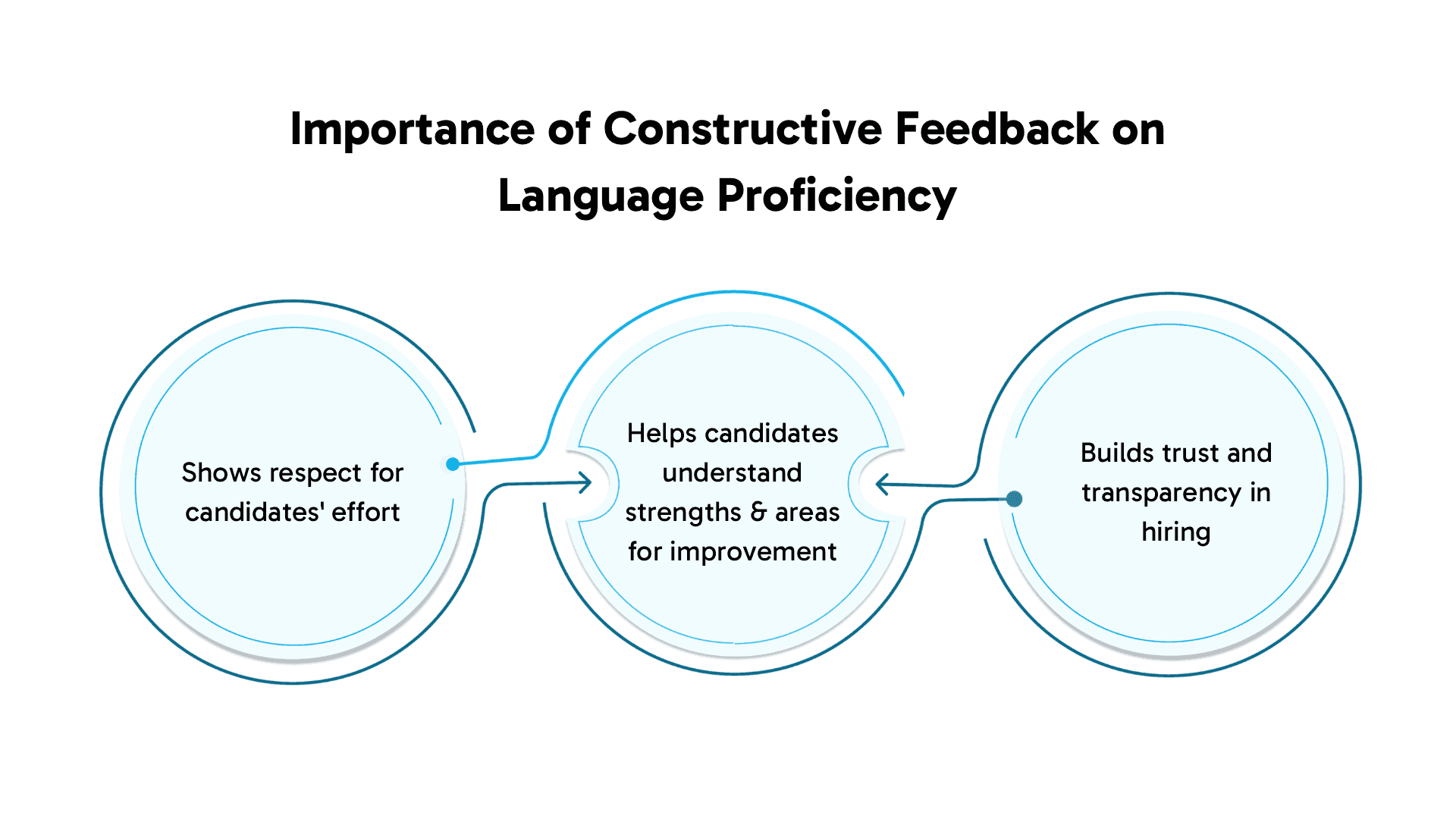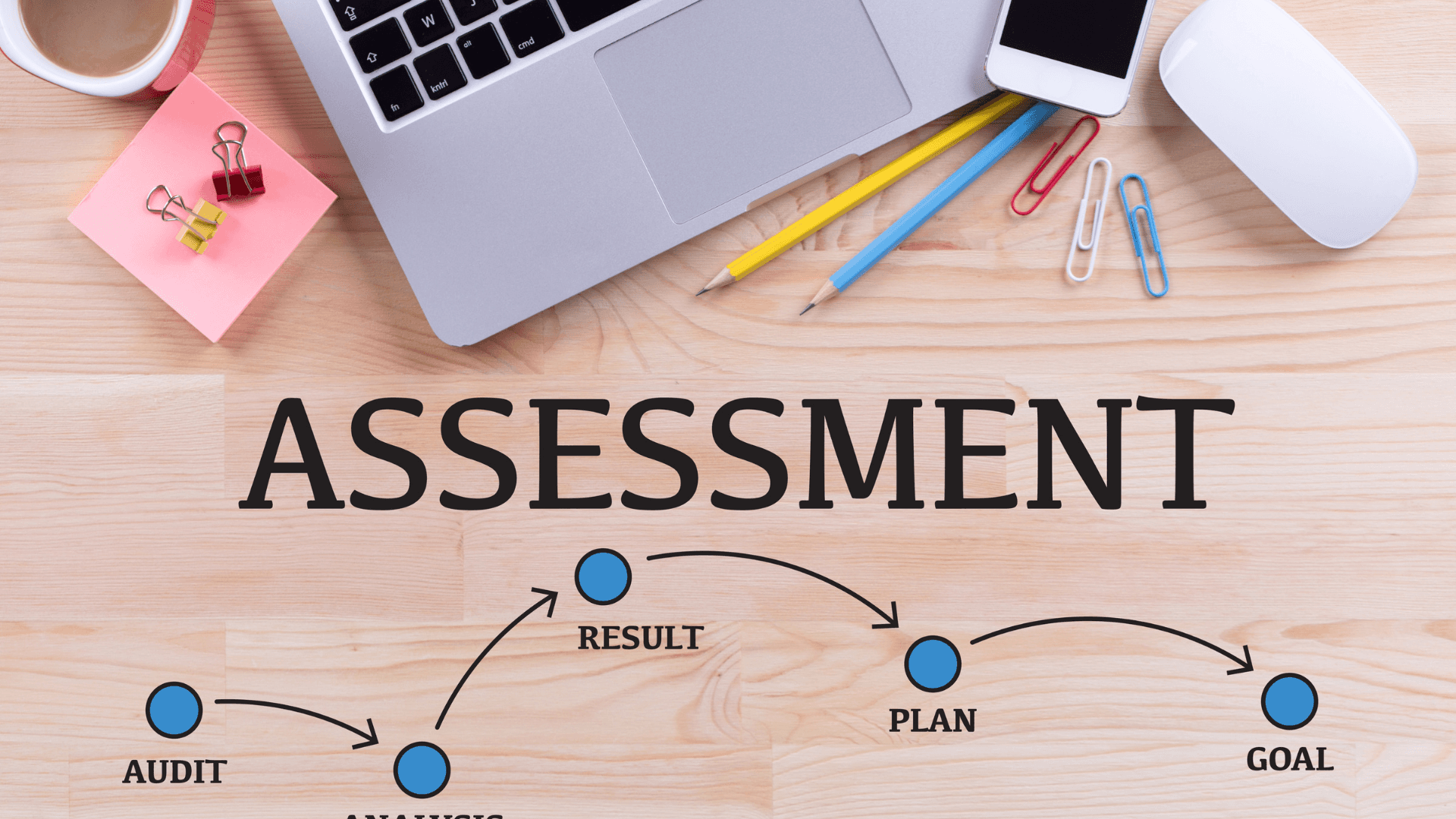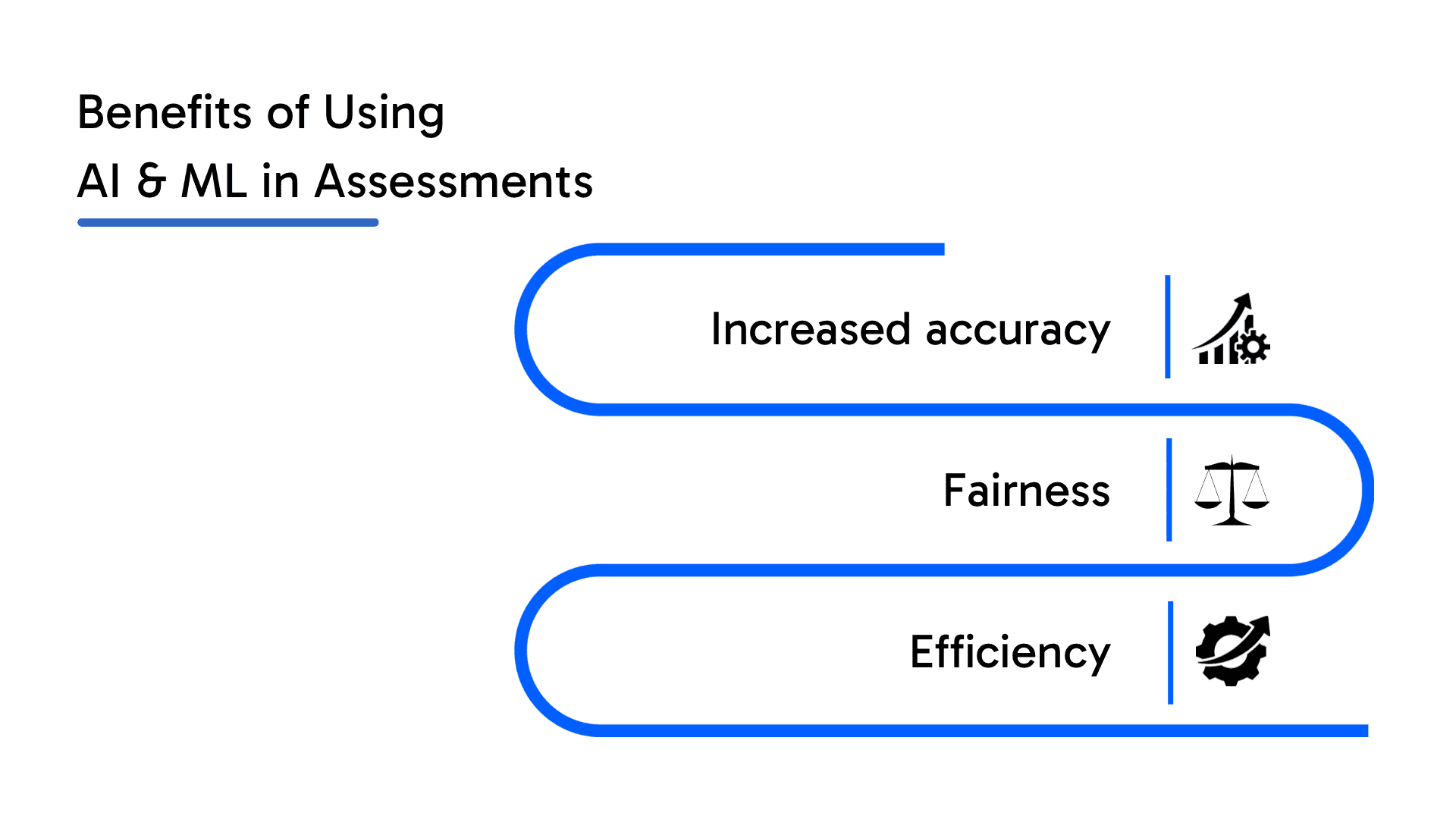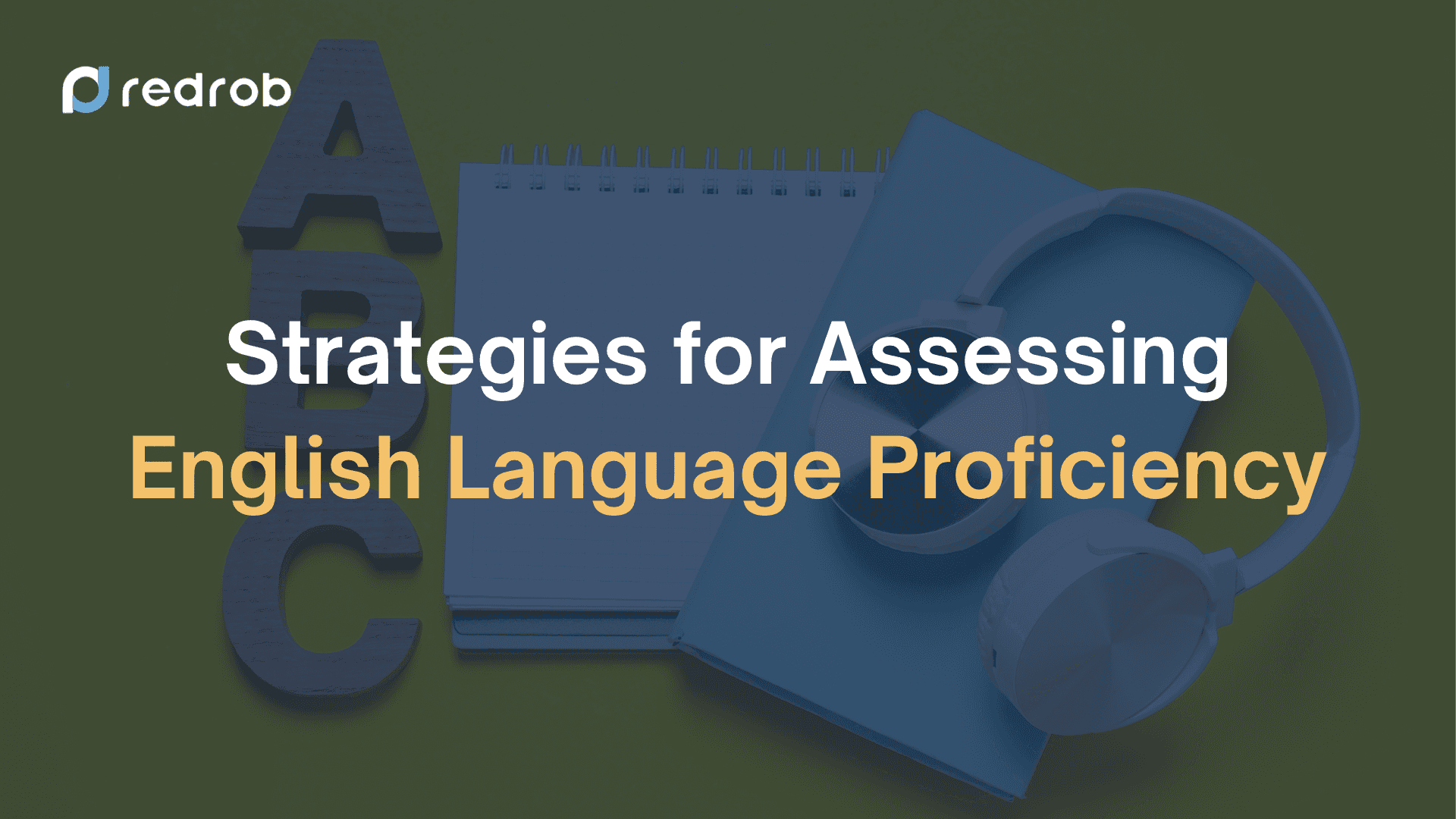English Proficiency
15 min read
•
Nov 6, 2024

Soumyata Singh
For the progressive business environment we operate today, strong English skills are essential. Whether you’re managing international teams or engaging with diverse customers, clear communication drives success. Assessing English language proficiency ensures that your employees can contribute effectively, boosting team collaboration and enhancing customer interactions.
Hiring the right talent means understanding how English proficiency impacts job performance. A customer service role might demand advanced communication skills, while technical roles could require only basic comprehension. Accurately assessing proficiency levels helps you make informed hiring decisions, placing the right people in the right positions. Want some effective strategies for assessing language skills? Keep Reading!
Defining English Language Proficiency for Job Roles
When assessing English language proficiency for hiring, it’s crucial to match language skills with specific job functions. Not every role requires the same level of fluency. By tailoring language requirements to the demands of each position, you ensure candidates can communicate effectively and succeed in their roles.
Customizing Proficiency Requirements Based on Specific Job Functions
Different roles demand different levels of language proficiency. Let’s consider the earlier example, customer service agents need strong conversational and written skills. They must interact with clients, answer questions, and solve problems in real time. A technical role, on the other hand, might prioritize understanding instructions, writing reports, or collaborating on projects. In this case, strong reading and comprehension skills may be more important than fluency in speaking.
By customizing proficiency requirements, you make sure your team can communicate at the right level. This also prevents mismatches where employees struggle to perform due to language barriers.
Aligning Language Proficiency with Job Descriptions and Company Goals
Clear job descriptions are vital for assessing English language proficiency. Your job listings should reflect the actual language needs of the role. For instance, if the role involves frequent communication with international clients, advanced language skills should be highlighted in the description.
Aligning language proficiency with company goals is equally important. A global company looking to expand into new markets might prioritize employees with a strong command of business English. In contrast, a local firm might focus more on basic proficiency that supports day-to-day operations. This ensures language skills directly contribute to the company’s success.
Understanding Proficiency Levels and Their Relevance to Job Tasks

English proficiency is commonly divided into three levels: basic, intermediate, and advanced. Each level corresponds to specific job tasks.
Basic proficiency covers simple communication. It’s useful for roles requiring basic instructions and limited verbal interaction, such as entry-level or manual labor positions.
Intermediate proficiency allows for more complex conversations and written communication. It’s often required for administrative or support roles where employees need to follow instructions and write reports or emails.
Advanced proficiency is essential for roles that involve negotiation, public speaking, or high-stakes decision-making. Jobs like senior management or sales, where clear and persuasive communication is key, often demand this level of proficiency.
Understanding these levels helps you tailor assessments to the specific demands of each role. This ensures that candidates possess the right language skills to meet job expectations.
Moving ahead, let’s explore the different types of assessments available for evaluating English language proficiency during the hiring process.
Types of English Language Proficiency Assessments
It’s important to choose the right type of test and approach for effectively assessing English language proficiency. The methods you select should match the needs of the role and reflect your company's standards. You can choose from formal standardized tests or informal, real-world tasks to evaluate a candidate’s abilities.
Formal Assessments
Formal assessments provide a structured way to measure a candidate’s English proficiency. These tests are standardized, making it easier to compare candidates. Common tests include TOEIC, IELTS, and company-specific language exams.
TOEIC (Test of English for International Communication) is often used in corporate settings. It measures English proficiency in everyday business environments. TOEIC tests listening and reading skills, making it ideal for roles requiring good comprehension.
IELTS (International English Language Testing System) is a globally recognized test that evaluates all four language skills: listening, reading, writing, and speaking. This is suitable for roles where communication is key, such as management or client-facing positions.
Company-specific language tests are tailored to your business. These tests allow you to assess skills directly related to your industry. For example, a tech company might test candidates on writing technical documentation in English.
How to Choose the Right Test for Your Organization’s Needs?
When choosing a test, consider the role’s communication demands. TOEIC may be best for roles focused on written or listening skills. IELTS, with its broader approach, suits jobs requiring strong verbal and written communication. Company-specific tests are helpful when you need to assess niche language skills. Always match the test to the job’s day-to-day tasks.
Pros and Cons of Standardized Testing
There are several pros and cons of standardized tests that you must consider:
Pros
Standardized tests provide a fair, measurable way to compare candidates.
They offer clear results on a candidate’s proficiency level.
Global recognition of tests like TOEIC and IELTS builds confidence in the results.
Cons
These tests can be expensive and time-consuming.
They may not reflect a candidate's ability to perform specific job tasks.
Some candidates may feel stressed, which could lower their scores.
Informal Assessments
Informal assessments offer a more flexible way of assessing English language proficiency. These methods focus on real-world communication and can be tailored to the job.
Role-plays and simulations are common methods. For instance, a customer service candidate might role-play a call with a difficult customer. This allows you to assess how they handle real-life scenarios.
Work-based tasks involve assigning relevant tasks like writing an email or conducting a short presentation. These tasks reveal how candidates communicate in a professional context.
Evaluating Practical Communication Skills During Interviews
During interviews, you can assess how candidates communicate in real-time. Ask questions that require thoughtful, clear responses. This allows you to observe their fluency, clarity, and ability to think on their feet. For roles that require fast decision-making, evaluating how candidates explain their reasoning in English can be insightful.
Observing Language Use in Real-Life Scenarios
Look at how candidates handle tasks like writing emails or delivering presentations. These activities reflect the actual communication skills required for the job. For example, you can ask a sales candidate to write a follow-up email after a mock client call. Their ability to convey ideas clearly and professionally is a strong indicator of their proficiency.
Combining both formal and informal methods gives a well-rounded view of a candidate’s language skills. We’ll discuss more of this later. In the next section, let’s explore strategies for effective English proficiency assessments, including pre-hire screening tools and interview techniques.

Strategies for Effective English Proficiency Assessment
Assessing English language proficiency effectively requires a combination of tools and approaches. A robust strategy ensures you identify candidates who can communicate clearly and meet job expectations. Here are some key strategies to help you evaluate language proficiency with confidence.
1. Pre-Hire Screening Tools
One of the easiest ways to assess English language proficiency early in the hiring process is through pre-hire screening tools. These tools help you filter candidates quickly and ensure only those with the necessary language skills move forward.
Use language tests during the initial application process
Make sure to choose the best online assessment platform such as Redrob, Indeed to help you out. These tests measure a candidate’s grammar, vocabulary, and comprehension skills. They’re useful for determining whether a candidate meets the basic language requirements for the role.
Implement AI-based tools to automate and standardize early screening
AI-based tools can streamline the process by automatically scoring language tests. These tools offer consistency and remove potential biases from human reviewers. An AI-driven platform can quickly assess a candidate’s grammar and fluency, providing a score that helps in shortlisting candidates. This reduces time spent on manual evaluation.
Incorporating Language Proficiency into Interviews
Interviews offer a great opportunity to assess English language proficiency in a more dynamic setting. However, it’s important to conduct language-focused interviews in a way that doesn’t overwhelm candidates.
Conduct Language-focused Interviews
Start by setting a relaxed tone. Make the conversation natural, rather than treating it as a test. Asking open-ended questions helps the candidate respond in a way that showcases their language skills. For example, ask them to describe a project or explain how they solved a problem at work.
Use structured questions to gauge fluency, comprehension, and pronunciation
Prepare a set of structured questions that cover different language aspects. Ask the candidate to explain something complex in simple terms to gauge comprehension. Listen for fluency and pronunciation as they respond. Structured questions ensure consistency across candidates and help you focus on the language skills most relevant to the role.
2. Task-Based Assessments
Task-based assessments offer practical insights into how a candidate will perform on the job. By assigning tasks that mirror real-world job duties, you can assess their ability to communicate in a professional setting.
Assigning role-specific tasks
You might ask a candidate to draft a business email or conduct a mock customer call. These tasks demonstrate their ability to write clearly and communicate in a real-time environment. According to several studies, more than half of the employers find task-based assessments the best predictor of on-the-job performance.
Benefits of assessing real-time communication performance
Real-time tasks give you a clear picture of how candidates handle pressure while communicating. It’s not just about grammar or vocabulary; it’s about how well they can get their message across. Watching them write an email or speak to a simulated customer provides valuable insights that standardized tests might miss.
Next, let’s discuss the importance of balancing formal and informal assessments to create a fair and comprehensive evaluation process.
Balancing Formal and Informal Assessments

When assessing English language proficiency, relying solely on formal tests may not give you a full picture. Combining formal and informal assessments ensures a more accurate evaluation of a candidate’s real-world communication skills. Here’s why balancing both is important and how you can manage time and resources effectively.
Formal assessments like TOEIC or IELTS offer a structured way to measure language proficiency. However, these tests often focus on theoretical knowledge and may not reflect how candidates communicate in actual work situations. By integrating real-world tasks, such as role-plays or job-specific assignments, you can observe how well candidates apply their language skills in a professional context.
For example, a candidate might score well on a standardized test but struggle in a live customer call simulation. Informal assessments reveal communication gaps that formal tests may miss. Many HR professionals believe that combining multiple assessment methods improves hiring accuracy. This approach provides a more complete view of a candidate's ability to perform job-specific tasks using English.
How to Balance Time and Resources Between Different Assessment Methods?
Balancing formal and informal assessments requires careful planning. Formal tests can be costly and time-consuming, while informal methods may demand more effort from hiring teams. The key is to use both strategically, focusing on the needs of the role.
Start with a formal test as a quick screening tool to filter out candidates who don’t meet basic proficiency levels. Online tests can be automated, saving time.
Follow up with informal assessments for candidates who pass the initial screening. These could include short tasks that mimic daily job functions, such as writing an email or conducting a short interview.
By blending these approaches, you can optimize your hiring process without wasting resources. A balanced approach also improves candidate experience, as it combines objective scores with practical, real-world evaluations.
Now, let’s look at how clear rubrics and evaluation criteria help maintain fairness and consistency across the assessment process.
Using Rubrics and Evaluation Criteria
Clear rubrics are essential when assessing English language proficiency for a specific role. They help standardize evaluations and ensure fairness across all candidates. A well-designed rubric can make your assessments more objective and reliable.
Developing Clear Rubrics to Assess Proficiency Consistently Across Candidates
A rubric is a scoring guide that defines specific criteria for evaluation. When assessing English language proficiency, a rubric outlines what you expect in areas like fluency, grammar, pronunciation, and comprehension. It provides a consistent framework, so every candidate is evaluated on the same standards.
For example, a rubric might score candidates on a scale of 1 to 5, with detailed descriptions of each level. This allows hiring managers to rate performance consistently, regardless of who conducts the interview or assessment.
To develop an effective rubric, align the criteria with the specific language skills needed for the role. A customer service role may prioritize clear pronunciation and listening skills, while a technical role might focus more on written communication. By customizing rubrics, you can tailor the assessment to match job demands.
How Rubrics Help Reduce Subjectivity in the Hiring Process?

Without a rubric, assessing English language proficiency can become subjective. Different interviewers may have different expectations, leading to inconsistent evaluations. A clear rubric helps remove personal bias and ensures that every candidate is judged on the same scale.
Rubrics also promote transparency. Candidates know what is being measured, and hiring managers can justify their decisions based on specific criteria. This approach not only improves fairness but also enhances the overall hiring experience.
By reducing subjectivity, rubrics help you make better hiring decisions. Taking a step further, let's explore how technology can further enhance language assessments.
Leveraging Technology for Language Assessments
Technology plays a crucial role in assessing English language proficiency. Modern tools and platforms make it easier to accurately and efficiently evaluate candidates for their communication skills. By incorporating AI and video interview solutions, you can streamline the hiring process while ensuring fairness and consistency.
Tools and Platforms to Streamline Language Testing
Various platforms simplify language proficiency assessment. Tools like Redrob, Duolingo for English and Versant offer quick, automated tests that evaluate listening, reading, and speaking skills. These platforms can save you time by delivering instant results and standardized evaluations.
Redrob: This AI-driven platform simplifies language testing with personalized assessments. It ensures your candidates are tested in real-world scenarios relevant to their job roles.
Duolingo for English: Duolingo offers affordable language proficiency tests with quick turnaround times. It’s a good choice for early-stage screening.
Versant: Versant uses AI to measure pronunciation, fluency, and comprehension. It's ideal for assessing spoken English skills in a structured manner.
These tools help you save time while providing detailed insights into your candidates' communication abilities.
Benefits of Using AI and Machine Learning in Assessments

AI and machine learning play a significant role in improving how you assess language proficiency. These technologies offer several benefits:
Increased accuracy: AI-driven assessments reduce human error by using data to provide precise results.
Fairness: Machine learning eliminates bias by standardizing evaluations, ensuring every candidate is treated equally.
Efficiency: Automated tools evaluate language skills in minutes, allowing you to focus on more complex hiring tasks.
By integrating these tools, you improve the reliability and fairness of your hiring process.
The Role of Video Interviews and Online Platforms
Video interviews and online platforms are also crucial in assessing English language proficiency. They give you a chance to evaluate verbal communication and real-time responses. Here’s how you can use them:
Video interviews: These allow you to assess fluency, pronunciation, and body language. You can observe how candidates handle spontaneous conversation, making it easier to gauge their practical language skills.
Online platforms: Platforms like Zoom or Google Meet can test language comprehension during group discussions or role plays. These are useful for evaluating candidates in customer service or management roles where clear communication is vital.
Using these tools, you gain deeper insights into how candidates perform under real-world conditions, enhancing your ability to make informed hiring decisions.
Up next, let’s see how to involve multiple stakeholders in setting realistic language expectations for your hiring process.
Involving Multiple Stakeholders in the Hiring Process
Assessing English language proficiency is not a one-person task. It requires input from various stakeholders to set clear and realistic expectations. By involving hiring managers, team leads, and language specialists, you ensure a comprehensive assessment that aligns with job requirements.
Collaborating with Hiring Managers and Team Leads
You need to work closely with hiring managers and team leads to define what language proficiency looks like for specific roles. Each job requires different levels of communication, and these stakeholders understand the nuances of their departments best. Their input helps you:
Set realistic language expectations based on job functions.
Align language requirements with the company’s operational goals.
Avoid overestimating or underestimating language skills needed for the job
For example, a customer service role might need strong conversational skills, while a technical role might only require basic comprehension. This collaboration ensures that your assessments target the right level of proficiency for each role.
Involving Language Specialists or Consultants
Bringing in language specialists or consultants adds an expert layer to your assessment process. These professionals can help you validate the methods you use for assessing English language proficiency. They ensure that your tests are accurate and fair across all candidates.
Language specialists can assist by:
Reviewing the structure and content of your language tests.
Providing feedback on role-specific tasks that assess real-world communication skills.
Offering advice on improving the assessment process.
This involvement helps you maintain high standards and consistency when evaluating candidates.
Involving multiple stakeholders ensures a balanced and accurate assessment process. Now let’s understand how to provide candidates with constructive feedback on their language proficiency post-interview.
Providing Feedback to Candidates
Assessing English language proficiency doesn’t end with the interview. Giving candidates clear feedback on their performance is crucial for their growth and your employer brand. Constructive feedback not only helps candidates but also enhances their experience with your company.
Why and How to Give Constructive Feedback on Language Proficiency Post-Interview

You should always provide constructive feedback on candidates' language skills after the interview. This is beneficial for several reasons:
It shows respect for the candidate's effort.
It helps candidates understand their strengths and areas for improvement.
It builds trust and transparency in your hiring process.
To give effective feedback, focus on specific examples from their interview. For instance, if a candidate struggled with pronunciation during a role-play, mention this in a positive, actionable way. Always balance feedback by highlighting both the strong and weak points.
The Importance of Offering Language Development Resources to Prospective Hires
Offering language development resources is a valuable way to help candidates improve. You can recommend tools or programs to those who need further development. Some effective resources include:
Online courses such as Duolingo for English or Babbel.
Language tutoring platforms like iTalki for personalized learning.
Self-paced learning modules focusing on business communication.
Providing these resources benefits candidates and shows your commitment to helping them grow, even if they aren’t hired. This step can help them prepare better for future opportunities.
How This Enhances Your Employer Brand and Candidate Experience
When you invest in providing feedback and resources, you improve your employer brand. Candidates appreciate companies that care about their development. This approach also enhances their experience during the hiring process, even if they don't get the job.
Research shows that 68% of candidates consider their interview experience a reflection of how the company treats employees. By giving constructive feedback and offering resources, you show that your company values professional growth. This can increase the likelihood of positive reviews and candidate referrals.
Providing thoughtful feedback and resources not only benefits candidates but also boosts your reputation as an employer.
Conclusion
A comprehensive and balanced strategy for assessing English language proficiency can significantly improve your hiring outcomes. By combining formal tests with practical tasks, you get a clearer picture of a candidate’s skills. This approach ensures that you find the right fit for each role, boosting team performance and overall communication.
As an HR professional, you should regularly refine your language testing methods. New tools and insights can help you stay up to date and ensure fair assessments. Invest time in reviewing your processes to keep them relevant and effective.
Aligning your language assessment practices with your organizational goals is key. Clear, consistent testing helps you hire candidates who contribute to your company's success. A strong language assessment strategy strengthens your hiring process and leads to better long-term results.
Redrob makes all this a lot easier and sophisticated for you. From candidate screening and interview management to comprehensive, customizable assessment tests - it has everything you need for effective hiring. Get to know us better.



